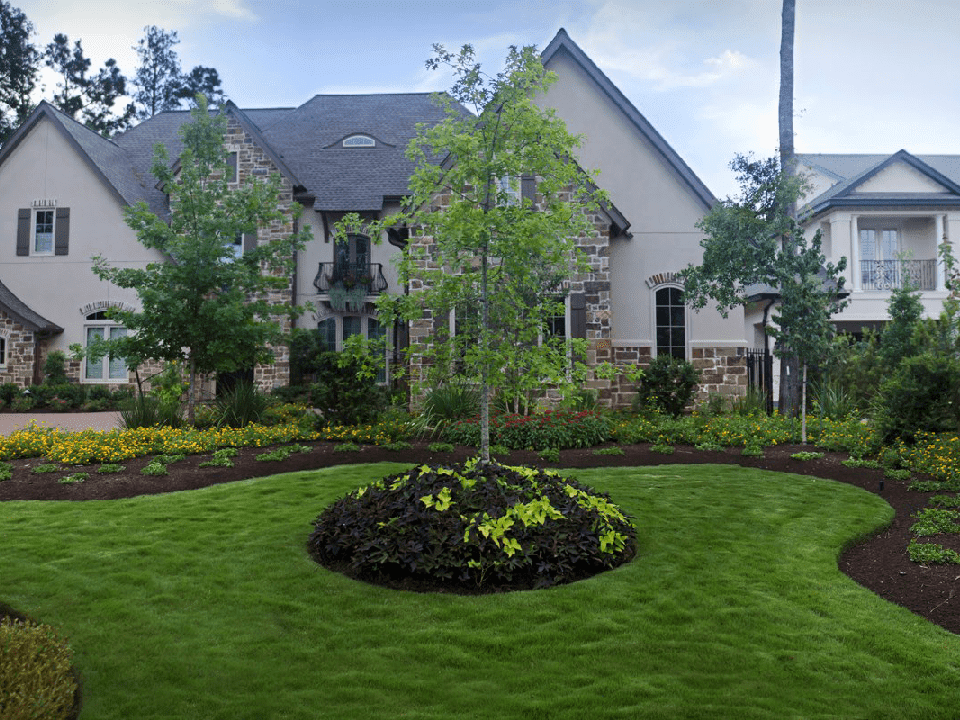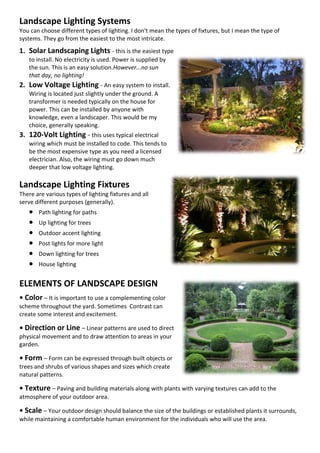The Greatest Guide To Hilton Head Landscapes
Table of ContentsThe Main Principles Of Hilton Head Landscapes How Hilton Head Landscapes can Save You Time, Stress, and Money.Some Known Questions About Hilton Head Landscapes.What Does Hilton Head Landscapes Do?Hilton Head Landscapes Things To Know Before You BuyAn Unbiased View of Hilton Head LandscapesSome Known Factual Statements About Hilton Head Landscapes 5 Simple Techniques For Hilton Head Landscapes
Kind compatibility is also a significant component of unity in designone or 2 noticeably different types benefit contrast and focus, however normally all various other kinds should have some similarities for a linked appearance. Texture refers to just how coarse or fine the surface area of the plant or hardscape material really feels and/or looks.
Examples of plants with coarse structure include philodendrons, agaves, bromeliads, hollies, hands, and hydrangeas. Hardscape with coarse appearance consists of rough-cut rock, rough-finished block, and incomplete wood with knots and an elevated grain. Aged or old building and construction product that preserves a weather-beaten surface is typically coarse in structure. Features that create great appearance include tiny foliage; slim, strappy leaves (yards) or high, thin stems; tiny, dense branches and tiny branches; long stems (creeping plants); and tiny, delicate blossoms.
Fascination About Hilton Head Landscapes
The majority of plants are medium appearance, in that they can not be described as having either rugged or fine texture. Medium-textured plants act as a background to link and link the crude- and fine-textured plants.

To make a space really feel smaller sized, place the rugged appearances along the external perimeter and the fine structures closest to the customer. The information of the rugged texture makes the plants appear closer and makes the room feel smaller. The viewed structure of plants can additionally change with the distance from the plant.
7 Easy Facts About Hilton Head Landscapes Explained
Strong shades increase the contrast and make the structure show up coarser, while low-key shades can squash structure. Hardscape with a crude texturesuch as extremely harsh rocks and bold, big timberstends to make all plant material show up more moderate textured. Designers often create a texture study (Number 8) theoretically to help choose the plan of plant materials.
Number 8. Texture study. Shade in plant material and hardscape includes passion and selection to the landscape. Shade is one of the most obvious component in the landscape and is normally the focus of many house owners; nevertheless, it is likewise one of the most short-term component, normally lasting just a few weeks a year for specific plants.
Hilton Head Landscapes Can Be Fun For Anyone
A basic summary of the shade wheel consists of the 3 primaries of red, blue, and yellow; the 3 second shades (a mix of two primaries) of environment-friendly, orange, and violet; and 6 tertiary shades (a mix of one nearby primary and second shade), such as red-orange. Shade theory clarifies the relationship of shades to every other and just how they must be made use of in a composition.

Comparable (occasionally called harmonious) color design are any 3 to 5 shades that are nearby on the shade wheel, such as red, red-orange, orange, yellow-orange, and yellow, or blue, blue-violet, and violet (landscape design hilton head). The shades are associated per other due to the fact that they usually include two primaries blended to create a second and 2 tertiary colors, which means they share common residential or commercial properties
They tend to have high contrast between them. The most usual collections are violet and yellow, red and green, and blue and orange. Corresponding shades are typically located normally in flowers; a common pair is yellow and violet. Color is located in the flowers, foliage, bark, and fruit of plants.
An Unbiased View of Hilton Head Landscapes
Environment-friendly vegetation in all its different tones is the leading color by amount, but various other colors record interest more conveniently due to their high contrast to the shade eco-friendly. Shade is likewise discovered in structures, rocks, pavers, wood, and furniture. The majority of colors in all-natural materials, such as rock and wood, are typically low-key and have a tendency to be variants of brownish, tan, and pale yellow.
Shades have residential properties that can affect feelings, spatial understanding, light high quality, balance, and focus. Trendy colors have a tendency to be relaxing and should be used in locations for leisure and serenity.
Excitement About Hilton Head Landscapes
Cool shades tend to recede and are viewed as being farther away, making a room really feel bigger. Shade can additionally be used to record interest and straight sights.
As an example, brilliant yellow, which has the greatest strength, likewise has a high comparison with all other shades (frequently referred to as a "pop" of color) and ought to be conserved. A percentage of extreme shade has as much aesthetic weight as a big amount of a much more controlled or weaker color.
Similar (sometimes called unified) color design are any type of 3 to five shades that are adjacent on the shade wheel, such as red, red-orange, orange, yellow-orange, and yellow, or blue, blue-violet, and violet. The colors relate to every various other because they generally consist of two primaries blended to develop an additional and two tertiary shades, which suggests they share common properties.
The 9-Second Trick For Hilton Head Landscapes
Complementary colors are typically found naturally in blossoms; a common pair is yellow and violet. Color is found in the blossoms, foliage, bark, and fruit of plants.
Green foliage in all its different shades is the leading shade by amount, but other colors capture interest quicker due to their high contrast to the color green - hilton head landscapers - https://www.find-us-here.com/businesses/Hilton-Head-Landscapes-Hilton-Head-Island-South-Carolina-USA/34094024/. Shade is likewise discovered in structures, rocks, pavers, wood, and furnishings. A lot of colors in natural products, such as rock and timber, are normally low-key and often tend to be variations of brownish, tan, and pale yellow
The Only Guide to Hilton Head Landscapes
Shade is an essential element for creating passion and range in the landscape. Colors have buildings that can impact feelings, spatial assumption, light top quality, balance, and emphasis. One residential or commercial property of color is explained about temperaturecolors appear to be amazing or warm and can impact emotions or feelings. Trendy shades often tend to be calming and must be utilized in locations for relaxation and serenity.
Cool colors tend to recede and like it are viewed as being further away, making a space feel larger. Shade can additionally be made use of to record interest and straight views - https://www.kickstarter.com/profile/h1tnhdlndscps/about.
Intense yellow, which has the highest strength, additionally has a high contrast with all various other shades (frequently explained as a "pop" of color) and ought to be utilized moderately. A percentage of intense color has as much visual weight as a large quantity of a more suppressed or weaker shade.